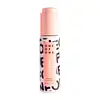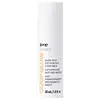What's inside
What's inside
 Key Ingredients
Key Ingredients

 Benefits
Benefits

 Concerns
Concerns

 Ingredients Side-by-side
Ingredients Side-by-side

Water
Skin ConditioningSimmondsia Chinensis Seed Oil
EmollientCI 77891
Cosmetic ColorantMica
Cosmetic ColorantGlycerin
HumectantPropanediol
SolventGluconolactone
Skin ConditioningSilica
AbrasiveAcrylates/C10-30 Alkyl Acrylate Crosspolymer
Emulsion StabilisingSodium Hydroxide
BufferingPhospholipids
Skin ConditioningSodium Hyaluronate
HumectantXanthan Gum
EmulsifyingCitric Acid
BufferingSodium Phytate
Calcium Gluconate
HumectantSodium Benzoate
MaskingCI 77491
Cosmetic ColorantWater
Skin ConditioningCaprylic/Capric Triglyceride
MaskingGlycolic Acid
BufferingSqualane
EmollientSodium Hydroxide
BufferingBehenyl Alcohol
EmollientGluconolactone
Skin ConditioningLactic Acid
BufferingGlycerin
HumectantPolyglyceryl-10 Dioleate
EmulsifyingPentylene Glycol
Skin ConditioningPropanediol
SolventMagnesium Aluminum Silicate
AbsorbentSodium Hyaluronate
HumectantAloe Barbadensis Leaf Juice
Skin ConditioningSalicornia Herbacea Extract
Skin ConditioningHydrogenated Lecithin
EmulsifyingHibiscus Sabdariffa Flower Extract
Skin ConditioningPiperonyl Glucoside
Skin ProtectingPolyglutamic Acid
Skin ConditioningAvena Sativa Bran Extract
AbrasiveTamarindus Indica Seed Polysaccharide
Skin ConditioningSimmondsia Chinensis Seed Oil
EmollientAdansonia Digitata Seed Oil
EmollientCitrullus Lanatus Seed Oil
EmollientPhospholipids
Skin ConditioningAdansonia Digitata Fruit Extract
EmollientCyclodextrin
AbsorbentXanthan Gum
EmulsifyingGlyceryl Undecylenate
EmollientGlyceryl Caprylate
EmollientTetrasodium Glutamate Diacetate
Caprylyl Glycol
EmollientEthylhexylglycerin
Skin ConditioningSclerotium Gum
Emulsion Stabilising1,2-Hexanediol
Skin ConditioningPolyglyceryl-10 Dipalmitate
EmollientSodium Benzoate
MaskingPotassium Sorbate
PreservativeCitric Acid
BufferingWater, Caprylic/Capric Triglyceride, Glycolic Acid, Squalane, Sodium Hydroxide, Behenyl Alcohol, Gluconolactone, Lactic Acid, Glycerin, Polyglyceryl-10 Dioleate, Pentylene Glycol, Propanediol, Magnesium Aluminum Silicate, Sodium Hyaluronate, Aloe Barbadensis Leaf Juice, Salicornia Herbacea Extract, Hydrogenated Lecithin, Hibiscus Sabdariffa Flower Extract, Piperonyl Glucoside, Polyglutamic Acid, Avena Sativa Bran Extract, Tamarindus Indica Seed Polysaccharide, Simmondsia Chinensis Seed Oil, Adansonia Digitata Seed Oil, Citrullus Lanatus Seed Oil, Phospholipids, Adansonia Digitata Fruit Extract, Cyclodextrin, Xanthan Gum, Glyceryl Undecylenate, Glyceryl Caprylate, Tetrasodium Glutamate Diacetate, Caprylyl Glycol, Ethylhexylglycerin, Sclerotium Gum, 1,2-Hexanediol, Polyglyceryl-10 Dipalmitate, Sodium Benzoate, Potassium Sorbate, Citric Acid
Ingredients Explained
These ingredients are found in both products.
Ingredients higher up in an ingredient list are typically present in a larger amount.
Citric Acid is an alpha hydroxy acid (AHA) naturally found in citrus fruits like oranges, lemons, and limes.
Like other AHAs, citric acid can exfoliate skin by breaking down the bonds that hold dead skin cells together. This helps reveal smoother and brighter skin underneath.
However, this exfoliating effect only happens at high concentrations (20%) which can be hard to find in cosmetic products.
Due to this, citric acid is usually included in small amounts as a pH adjuster. This helps keep products slightly more acidic and compatible with skin's natural pH.
In skincare formulas, citric acid can:
While it can provide some skin benefits, research shows lactic acid and glycolic acid are generally more effective and less irritating exfoliants.
Most citric acid used in skincare today is made by fermenting sugars (usually from molasses). This synthetic version is identical to the natural citrus form but easier to stabilize and use in formulations.
Read more about some other popular AHA's here:
Learn more about Citric AcidGluconolactone is a PHA. PHAs are a great gentle alternative to traditional AHAs.
When applied, Gluconolactone has the same affect on skin as AHAs such as lactic acid. It helps dissolve the dead skin cells in the top layer of your skin. This improves texture and brightens the skin.
PHAs are more gentle than AHAs due to their larger structure. They do not penetrate as deeply as AHAs and take a longer time to dissolve dead cells. Studies show PHAs do not cause as much irritation.
Gluconolactone has some interesting properties:
In a 2004 study, Gluconolactone was found to prevent UV damage in mouse skin cells and has not been found to increase sun sensitivity. However, we still recommend wearing SPF daily.
This ingredient is is an created by reacting gluconic acid with an alcohol.
Learn more about GluconolactoneGlycerin is already naturally found in your skin. It helps moisturize and protect your skin.
A study from 2016 found glycerin to be more effective as a humectant than AHAs and hyaluronic acid.
As a humectant, it helps the skin stay hydrated by pulling moisture to your skin. The low molecular weight of glycerin allows it to pull moisture into the deeper layers of your skin.
Hydrated skin improves your skin barrier; Your skin barrier helps protect against irritants and bacteria.
Glycerin has also been found to have antimicrobial and antiviral properties. Due to these properties, glycerin is often used in wound and burn treatments.
In cosmetics, glycerin is usually derived from plants such as soybean or palm. However, it can also be sourced from animals, such as tallow or animal fat.
This ingredient is organic, colorless, odorless, and non-toxic.
Glycerin is the name for this ingredient in American English. British English uses Glycerol/Glycerine.
Learn more about GlycerinPhospholipids are naturally found in our skin as they are the main component of cell membranes. Phospholipids have humectant, emollient, antioxidant properties.
Phospholipids are complex lipids that contain glycerin, two fatty acids, and a phosphate group. Some foods that contain phospholipids include soybeans and milk. The phospholipids found in soy come from Lecithin. This ingredient can also be synthetically created.
Due to their hygroscopic nature, they act as both humectants and emollients. Humectants draw moisture from the air to your skin, while emollients help trap moisture in.
The phospholipids in our skin can be naturally depleted. Replenishing the phospholipids in our skin can help hydrate your skin.
Studies show phospholipids display antioxidant activity and may help with reducing the signs of aging.
This ingredient is non-occlusive.
Some types of phospholipids:
Learn more about PhospholipidsPropanediol is an all-star ingredient. It softens, hydrates, and smooths the skin.
It’s often used to:
Propanediol is not likely to cause sensitivity and considered safe to use. It is derived from corn or petroleum with a clear color and no scent.
Learn more about PropanediolThis oil comes from the seeds of the desert shrub called Jojoba. It is more commonly known as jojoba oil, a non-comedogenic oil.
Jojoba oil does not contain fragrance and has many fatty-acids, making it a great soothing ingredient.
It also contains Vitamin E, a great moisturizing ingredient. Vitamin E is also an antioxidant and protects your skin against oxidative damage.
This ingredient humectant properties, meaning it helps draw moisture from the air. This helps keep your skin hydrated.
While jojoba has antibacterial properties, it is only able to kill some strains of bacteria.
Studies also show it helps in wound healing. In fact, Indigenous cultures have used jojoba as a moisturizer and to help treat burns for centuries.
Fun fact: Jojoba oil similar to natural human skin sebum, so it has a great effect on dry skin. It is also promising with helping to regulate sebum production.
Due to its fatty acid content, Jojoba oil may not be fungal acne safe. We recommend speaking with a professional if you have any concerns.
Learn more about Simmondsia Chinensis Seed OilSodium Benzoate is a preservative. It's used in both cosmetic and food products to inhibit the growth of mold and bacteria. It is typically produced synthetically.
Both the US FDA and EU Health Committee have approved the use of sodium benzoate. In the US, levels of 0.1% (of the total product) are allowed.
Sodium benzoate works as a preservative by inhibiting the growth of bacteria inside of cells. It prevents the cell from fermenting a type of sugar using an enzyme called phosphofructokinase.
It is the salt of benzoic acid. Foods containing sodium benzoate include soda, salad dressings, condiments, fruit juices, wines, and snack foods.
Studies for using ascorbic acid and sodium benzoate in cosmetics are lacking, especially in skincare routines with multiple steps.
We always recommend speaking with a professional, such as a dermatologist, if you have any concerns.
Learn more about Sodium BenzoateSodium Hyaluronate is hyaluronic acid's salt form. It is commonly derived from the sodium salt of hyaluronic acid.
Like hyaluronic acid, it is great at holding water and acts as a humectant. This makes it a great skin hydrating ingredient.
Sodium Hyaluronate is naturally occurring in our bodies and is mostly found in eye fluid and joints.
These are some other common types of Hyaluronic Acid:
Learn more about Sodium HyaluronateSodium Hydroxide is also known as lye or caustic soda. It is used to adjust the pH of products; many ingredients require a specific pH to be effective.
In small amounts, sodium hydroxide is considered safe to use. However, large amounts may cause chemical burns due to its high alkaline.
Your skin has a natural pH and acid mantle. This acid mantle helps prevent harmful bacteria from breaking through. The acid mantle also helps keep your skin hydrated.
"Alkaline" refers to a high pH level. A low pH level would be considered acidic.
Learn more about Sodium HydroxideWater. It's the most common cosmetic ingredient of all. You'll usually see it at the top of ingredient lists, meaning that it makes up the largest part of the product.
So why is it so popular? Water most often acts as a solvent - this means that it helps dissolve other ingredients into the formulation.
You'll also recognize water as that liquid we all need to stay alive. If you see this, drink a glass of water. Stay hydrated!
Learn more about WaterXanthan gum is used as a stabilizer and thickener within cosmetic products. It helps give products a sticky, thick feeling - preventing them from being too runny.
On the technical side of things, xanthan gum is a polysaccharide - a combination consisting of multiple sugar molecules bonded together.
Xanthan gum is a pretty common and great ingredient. It is a natural, non-toxic, non-irritating ingredient that is also commonly used in food products.
Learn more about Xanthan Gum